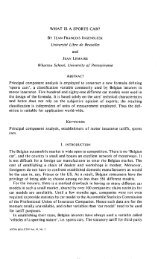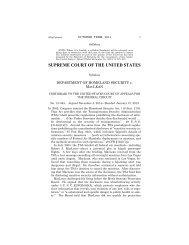85jct_catalan
Create successful ePaper yourself
Turn your PDF publications into a flip-book with our unique Google optimized e-Paper software.
252 FtiRLINGER AND HOFBAUER<br />
Proof: We replace z by qz in (2.5) divide by q, add C,, = 1 on both<br />
sides and divide by I + 17 to obtain<br />
Now we “square” this equation in the same manner as we have done above<br />
with (2.1):<br />
After a multiplication with z we can compare coefficients with (2.5) which<br />
gives exactly (2.2). So we see that the numbers C, defined by (2.5) satisfy<br />
the recurrence relation (2.2) and hence coincide with our q-Catalan numbers.<br />
1<br />
We now turn to the combinatorial<br />
C’,, = c q’“““.<br />
II i R ,)<br />
meaning of these q-Catalan numbers,<br />
(2.6)<br />
For the proof we decompose a Catalan word u’ E %$ + , in the usual way<br />
into M’ = OK,, lw, with M?, E gk, M’~ E U;, k for some k with 0 6 k 6 n. Then<br />
the number of inversions in w is given by<br />
Hence C (q’“vw: M:E $$,) satisfies the same recursion (2.2) as C,, which<br />
completes the proof of (2.6).<br />
Geometrically the inversion number of u’ means the area of the polygon<br />
which lies between the lattice path of M’ and that of the word 0.. . 01 . 1<br />
without inversions. Viewing this polygon as the Ferrers graph of a partition<br />
(see [2]) gives an interpretation of the Catalan numbers C,(q)=<br />
cm Cnmq” in terms of partitions: C,,, is the number of partitions<br />
(A, 3 J-2,..., L,) of m with 1,~ n-i + I. From this we may infer, e.g., the<br />
asymptotic formula for<br />
Iq/





